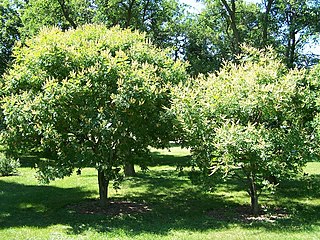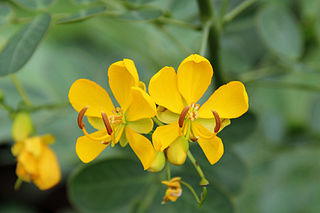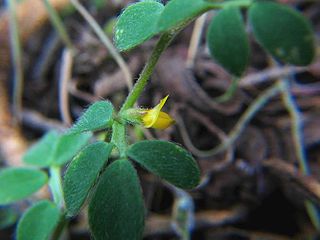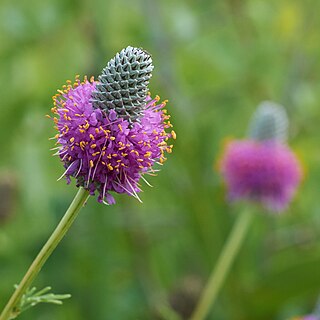
Thermopsis rhombifolia, also known as prairie thermopsis, is a flowering plant in the legume family. It is native to North America, where it is found in the Great Plains, with extensions into the lower canyons of the Rocky Mountains. Its natural habitat is dry grasslands and woodlands.

Maackia is a genus of flowering plants in the legume family, Fabaceae. There are about 12 species, all native to eastern Asia, with six endemic to China. The generic name honors the botanist Richard Maack.

Thermopsis is a genus of legumes, native to temperate North America and east Asia. They are herbaceous perennials and are known as goldenbanners or false-lupines.

Senna bicapsularis is a species of the legume genus Senna, native to northern South America, from Panama south to Venezuela and Colombia, and also the West Indies. Common names include rambling senna, winter cassia, Christmas bush, money bush, and yellow candlewood. In Florida, Senna pendula is usually cultivated as, and misapplied to, S. bicapsularis.

Potentilla gracilis, known as slender cinquefoil or graceful cinquefoil, is a species of cinquefoil. It ranges from Alaska down the west coast of Canada and the United States, and Colorado.

Amphicarpaea bracteata is an annual to perennial vine in the legume family, native to woodland, thickets, and moist slopes in eastern North America.

Astragalus acutirostris is a species of milkvetch known by the common name sharpkeel milkvetch. It is native to the Mojave Desert and surroundings of California, Nevada, and Arizona, where it grows in dry, sandy, gravelly areas.

Thermopsis villosa, or Aaron's rod, is an herbaceous plant in the legume family. Its native range is in North America, in the southern Appalachian mountains. It is found elsewhere as an escape from cultivation.

Hosackia gracilis, synonym Lotus formosissimus, is a species of legume native to western North America from British Columbia through Washington and Oregon to California. It was first described by George Bentham. It is known by the common name harlequin lotus. It grows in moist spots in the coastal mountains and down to the oceanside bluffs. It is a perennial herb growing upright or spreading to about 0.5 m in maximum length. It is lined with leaves each made up of a few oppositely arranged oval leaflets up to 2 cm long. The inflorescence is made up of several pealike flowers each 1 to 2 cm long. The flower has a bright yellow banner, or upper petal, and bright pink or white lower petals. The fruit is a legume pod 2 to 3 cm long.
Acmispon junceus, synonyms Lotus junceus and Syrmatium junceum, is a species of legume native to California. It is known by the common names rush broom and rush deervetch. It is endemic to California, where it is known from the northern and central coast and the coastal mountain ranges. It can be found from beaches inland to serpentine slopes and chaparral. It is a hairy, prostrate or spreading perennial herb lined with leaves each made up of small oval leaflets. The inflorescence bears up 8 yellow pealike flowers each up to about a centimeter long. The fruit is a small beaked legume pod.

Marina parryi is a species of flowering plant in the legume family known by the common name Parry's false prairie-clover. It is native to the deserts of the southwestern United States and northern Mexico. This is a perennial herb producing stiff, branching stems 20 to 80 centimeters long. It is coated with glands and rough hairs. The leaves are made up of several pairs of small oval leaflets no more than 6 millimeters long. The inflorescence is a raceme of deep blue and white bicolored flowers each under a centimeter long. The fruit is a legume pod containing a single seed.

Psorothamnus polydenius is a species of flowering plant in the legume family known by the common names Nevada dalea and Nevada indigobush. It is native to the deserts of the southwestern United States from the Mojave Desert in California to Utah.
Rupertia hallii is a species of flowering plant in the legume family known by the common name Hall's California tea, or Hall's rupertia. It is endemic to California, where it is known only from a small section of the northern Sierra Nevada foothills on the border between Butte and Tehama Counties. It is a perennial herb approaching a meter in height with slender, leafy branches. The leaves are each made up of three lance-shaped or oval, pointed leaflets measuring up to 9 centimeters long. The inflorescence is a clustered raceme of several whitish or yellowish pealike flowers. Each flower has a tubular calyx of sepals and a corolla spreading to about a centimeter in width. The fruit is a hairy, gland-speckled legume around a centimeter long.

Senna multiglandulosa is a species of flowering plant in the legume family known by several common names, including glandular senna, downy senna, and buttercup bush. It is native to Mexico, Guatemala, and western parts of South America, but it is widely cultivated as an ornamental plant and in some areas of the world has become naturalized in the wild. In some places it is considered a weed, for example, in New Zealand and New South Wales.

Thermopsis californica, known by the common name California goldenbanner, is a species of flowering plant in the legume family.

Thermopsis macrophylla is a species of flowering plant in the legume family known by the common names Santa Inez goldenbanner and Santa Ynez false-lupine.

Acmispon wrangelianus is a species of legume native to California and Oregon in the southwestern United States. It is known by the common names Chilean bird's-foot trefoil and Chile lotus. Despite its common name, it is not from Chile. It can be found in many types of habitat, including disturbed areas. This is a hairy, prostrate annual herb. Its slender branches are lined with leaves each made of generally four small leaflets. The inflorescence is composed of a solitary yellow pealike flower around a centimeter wide. The fruit is a legume pod 1 to 2 centimeters long.

Dalea purpurea is a species of flowering plant in the legume family known as purple prairie clover. Native to central north America, purple prairie clover is a relatively common member of the Great Plains and prairie ecosystems. It blooms in the summer with dense spikes of bright purple flowers that attract many species of insects.
Thermopsis mollis is a species of flowering plant in the legume family known by the common names Allegheny Mountain goldenbanner, soft bush pea, and soft-haired thermopsis. It is native to the southeastern United States from southern Virginia to northern Georgia.

Thermopsis lanceolata, the tapered false lupin, is a species of flowering plant in the legume family Fabaceae, native to Russia (Siberia), Kazakhstan, Mongolia, Nepal and China. Growing to 1 m (3.3 ft) tall and broad, this herbaceous perennial has grey-green leaves and erect tapering panicles of pale yellow, pea-like flowers in spring. It is closely related to the familiar lupins of gardens, but with a more bushy appearance.
















